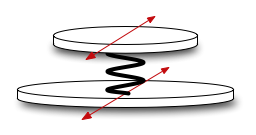Two-Mass - Mono-directional
Description
A simple mono-directional two-mass model that can serve as a hammer, plectrum, finger, etc. Generally the two-mass model has a small mass and a large mass; the small one will be "connected" to the object being excited, and the large one will be manipulated by the user. This is similar to the bi-two-mass, except that it only vibrates in the trans0 direction. It is therefore more computationally efficient for single-direction interactions like plucking and striking objects.

Syntax and Default Values
A 'mono-two-mass can be created using the following Mlys (Max), mlys.lua, or Lisp syntax:
In Modalys for Max, this object is named mlys.mono-two-mass:
TODO
modalys.make_object{ kind="mono-two-mass", name="MyMonoTwoMass",
smallmass=0.01, largemass=0.01,
stiffness=15000, freqloss=100, constloss=0 }
(make-object 'mono-two-mass
(small-mass .01)
(large-mass .01)
(stiffness0 15000)
(freq-loss0 100)
(const-loss0 0))
Parameters
All physical parameters can be numerical values or controllers.
- small-mass: The mass of the small mass in kg.
- large-mass: The mass of the large mass in kg.
- stiffness: The stiffness of the spring in the 'trans0 (horizontal) direction.
- freq-loss: The usual frequency loss parameter. See the General Object Information for more info.
- const-loss: The usual constant loss parameter. See the General Object Information for more info..
As always, the term horizontal used above is provided for simplification.
Accesses
A 'bi-two-mass can be accessed only in its sole vibrational direction: trans0.
(make-access my-mono-two-mass my-controller 'trans0)
★